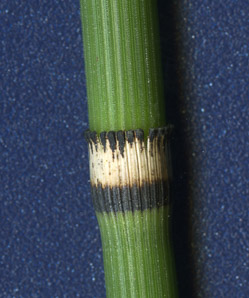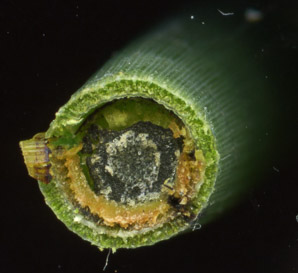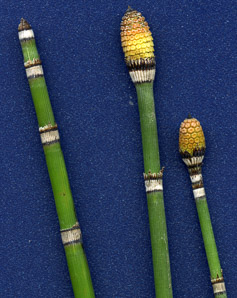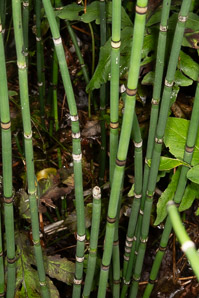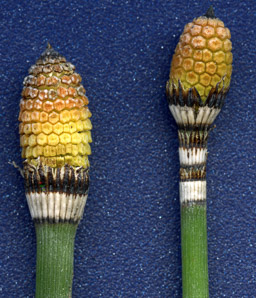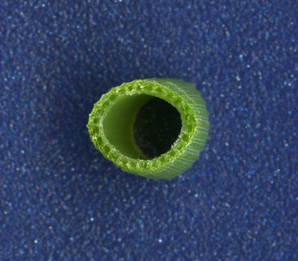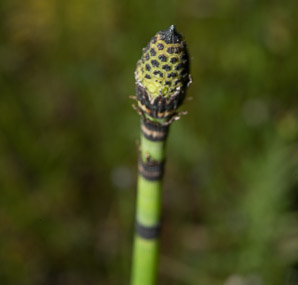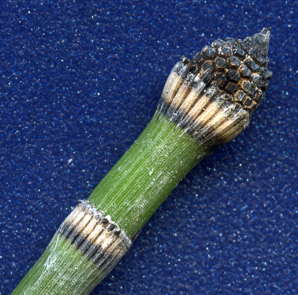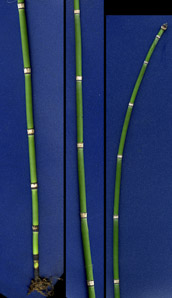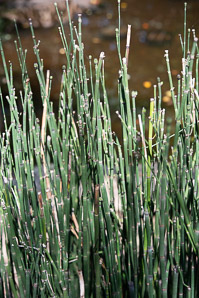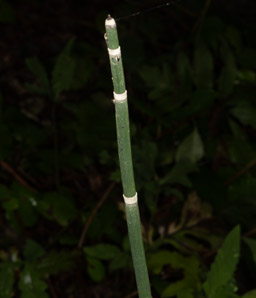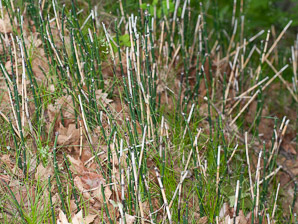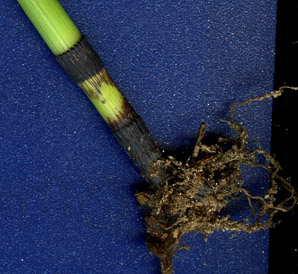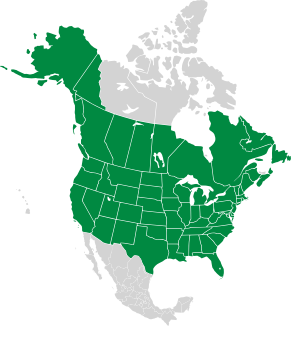
|
Equisetum hyemale L. Rough horsetail, common scouring rush
The horsetail genus, Equisetum, is pretty much in a class by itself, a class with a very long history. A horsetail is not a flowering plant, and although it has a cone-like reproductive structure, it is not a conifer. It is not a rush or a grass either. Horsetails are grouped loosely with ferns, both of which predate flowering plants, because ferns also reproduce with spores and do not flower. But they aren’t ferns either. They are primitive vascular plants. Relatives of this group show up in the fossil record, dating back to the late Devonian period, about 375 million years ago. Rough horsetails are found throughout North America and Eurasia. They favor areas that are reliably wet at least most of the year—wetlands, stream and river edges, seeps—forming colonies that are sometimes invasive. Plants: Why is a plant that resembles an ancient crazy tall asparagus spear, or in cross-section, a tall green soda straw, called a horsetail? Because many members of this genus have a bushy, fine-grained branching structure that loosely resembles a horse’s tail. Rough horsetail, though, is most often a single unbranched, dark green stem, 7-86″ (17-218 cm) tall. They are evergreen, and occur in colonies, spreading by underground roots. Each stem is punctuated by nodes surrounded by sheaths. The sheaths are actually tiny leaves, fused to the stem. The nodes provide structural support, a trick also evolved by grasses (including bamboo) and a number of flowering plants. In cross section, stems of rough horsetail are largely hollow, more so than in other horsetails. The stems feel rough to the touch. So how can a flimsy-looking “soda straw” sometimes reach over 7 feet in height? Part of it is the nodes, which provide support. But the plant has another trick: it incorporates silica, tiny little glass balls of it, into its stem. It absorbs silicic acid, a mild acid present in small quanitites in the wet soil, and converts it to silica—the same silica in glass or sand. This accounts for its unusual stiffness, the rough feel of the stems, and for its historical use for polishing or scouring metal and wood. See Equisetum for a comparison chart. Leaves: Technically, the tiny sheaths ringing the stem at regular intervals are groups of vestigial leaves, but they serve no purpose for the plant. Photosynthesis occurs in the stem. Each sheath has a black band at both the bottom and top, while smooth-stemmed horsetail has a black band only at the top. The sheaths are initially green, becoming light gray with age. Fruits: Conelike structures at stem tips, called strobili, are ½-1″ (1.3-2.5 cm), with sharp tips. Online References:
Wikipedia (Equisetaceae) Pubmed.ncbi.nlm.nih.gov (The role of silica in these plants) References:
The sheaths are black at both the bottom and top. · 10/25/2023 · Mitchell Field, Harpswell, Maine The diameter of this young stalk is about 1/4 inch. · 7/29/2023 · Papermill Trail/Miller Park, Lisbon, Maine 7/29/2023 · Papermill Trail/Miller Park, Lisbon, Maine 9/3/2020 · Mitchell Field, Harpswell, Maine · ≈ 6 × 10″ (16 × 24 cm) The tallest of the yellow "cones" is 0.5 inches high. · 7/29/2023 · Papermill Trail/Miller Park, Lisbon, Maine
Equisetum hyemale description by Thomas H. Kent, last updated 4 Aug 2023. © FloraFinder.org. All rights reserved. |
4/6/2010 · Nashua River Rail Trail, Groton, Massachusetts · ≈ 14 × 9″ (35 × 23 cm) This is a little less than 1/4" in diameter. The valecular canals (green tubes encircling the stem) are much smaller than the central cavity. The stem is round: the oval shape resulted from a dull knife. · 10/25/2023 · Mitchell Field, Harpswell, Maine 9/4/2013 · Amos Kendall Conservation Area, Dunstable, Massachusetts · ≈ 3 × 4½″ (8 × 12 cm) The cone is typically 1/2-1", with a sharp tip. · 7/29/2023 · Mitchell Field, Harpswell, Maine I had to fit in on the scanner somehow. This individual is about 32 inches high. · 11/17/2020 · Mitchell Field, Harpswell, Maine 8/31/2013 · Lewis Ginter Botanical Garden, Richmond, Virginia · ≈ 1 × 2′ (39 × 59 cm) 9/3/2020 · Mitchell Field, Harpswell, Maine · ≈ 5 × 8″ (13 × 20 cm) 5/29/2010 · Maine Audubon Gilsland Farm Audubon Center, Falmouth, Maine Sheaths near the base are darker, and bulge somewhat compared to the stems. The bulging often appears up further as well in older plants. · 7/29/2023 · Mitchell Field, Harpswell, Maine Range: Zones 4-9:
|
